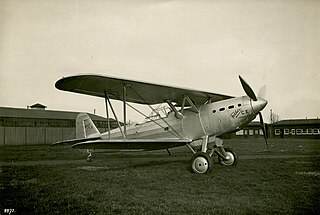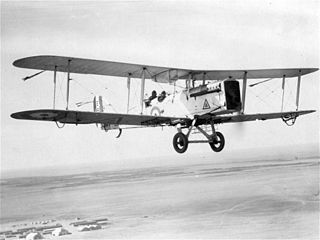
The Napier Lion is a 12-cylinder, petrol-fueled 'broad arrow' W12 configuration aircraft engine built by D. Napier & Son from 1917 until the 1930s. A number of advanced features made it the most powerful engine of its day and kept it in production long after other contemporary designs had been superseded. It is particularly well known for its use in a number of racing designs, for aircraft, boats and cars.

The Rolls-Royce Spey is a low-bypass turbofan engine originally designed and manufactured by Rolls-Royce that has been in widespread service for over 40 years. A co-development version of the Spey between Rolls-Royce and Allison in the 1960s is the Allison TF41.

The Gulfstream V is a long-range, large business jet aircraft produced by Gulfstream Aerospace, derived from the previous Gulfstream IV. It flies up to Mach 0.885, up to 51,000 feet (16,000 m) and has a 6,500 nmi (12,000 km) range. It typically accommodates four crew and 14 passengers. It first flew on November 28, 1995, and entered service in June 1997. It is used by the US military under the designation C-37A. It is followed by an improved version, the Gulfstream 550.

The Fairey Aviation Company Fairey III was a family of British reconnaissance biplanes that enjoyed a very long production and service history in both landplane and seaplane variants. First flying on 14 September 1917, examples were still in use during the Second World War.

The Vickers Viking was a British single-engine amphibious aircraft designed for military use shortly after World War I. Later versions of the aircraft were known as the Vickers Vulture and Vickers Vanellus.

The Rolls-Royce Kestrel is a 21.25 litre V-12 aircraft engine from Rolls-Royce. It was their first cast-block engine, and used as the pattern for most of their future piston-engine designs. Used during the interwar period, it was fitted to a number of British fighters and bombers of the era, including the Hawker Fury and Hawker Hart family, and the Handley Page Heyford. The Kestrel engine was also sold to international air force customers, in this role it used to power prototypes of the German Messerschmitt Bf 109 and the Junkers Ju 87 "Stuka" dive-bomber, as the Junkers Jumo 210 engines were not ready to be fitted. Several examples of the Kestrel engine remain airworthy today.

The Fokker D.XXI fighter was designed in 1935 by Dutch aircraft manufacturer Fokker in response to requirements laid out by the Royal Netherlands East Indies Army Air Force.

The Fokker C.X was a Dutch biplane scout and light bomber designed in 1933. It had a crew of two.

The Dassault MD.454 Mystère IV is a 1950s French fighter-bomber aircraft, the first transonic aircraft to enter service with the French Air Force. It was used in large-scale combat in the Israeli Air Force during the 1967 Six Day War.

The Fokker C.V was a Dutch light reconnaissance and bomber biplane aircraft manufactured by Fokker. It was designed by Anthony Fokker and the series manufacture began in 1924 at Fokker in Amsterdam.

The Fokker F.VII, also known as the Fokker Trimotor, was an airliner produced in the 1920s by the Dutch aircraft manufacturer Fokker, Fokker's American subsidiary Atlantic Aircraft Corporation, and several other companies under licence.

The Fokker S.14 Machtrainer is a two-seater military training jet aircraft designed and manufactured by the Dutch aircraft manufacturer Fokker for the Royal Netherlands Air Force (RNLAF). It has the distinction of being one of the first dedicated jet-powered training aircraft to be produced in the world. The unarmed trainer served with Dutch Air Force for 12 years, and one prototype was used by the Dutch Aerospace labs for 6. Two were lost in air crashes, one in 1955 and a second in 1964. The Machtrainer features side-by-side seating with a single engine, although a under-belly gun pod and hardpoints were designed but not put into use.

The Handley Page W.8, W.9 and W.10 were British two- and three-engine medium-range biplane airliners designed and built by Handley Page.

The Airco DH.9A is a British single-engined light bomber that was designed and first used shortly before the end of the First World War. It was a development of the unsuccessful Airco DH.9 bomber, featuring a strengthened structure and, crucially, replacing the under-powered and unreliable inline 6-cylinder Siddeley Puma engine of the DH.9 with the American V-12 Liberty engine.

The Fairey Fawn was a British single-engine light bomber of the 1920s. It was designed as a replacement for the Airco DH.9A and served with the Royal Air Force between 1924 and 1929.

The Swearingen Merlin or the Fairchild Aerospace Merlin is a pressurized, twin turboprop business aircraft first produced by Swearingen Aircraft, and later by Fairchild at a plant in San Antonio, Texas.

The Fokker F-11 was a luxury flying boat produced as an 'air yacht' in the United States in the late 1920s. Technically the aircraft was the Fokker Aircraft Corporation of America's Model 9. It was sold in North America as the Fokker F-11 and was offered in Europe as the Fokker B.IV. By the time the first six aircraft had been constructed, it was already evident that the design was not going to sell well. A few were sold, two to notable multi-millionaires; Harold Vanderbilt and Garfield Wood each purchasing one. One was bought by Air Ferries in San Francisco. The F-11A cost $40,000 but the price was slashed to $32,500 as the depression set in during 1930. The F-11 was a commercial failure.

The Fokker T.IV was a Dutch torpedo bomber/maritime reconnaissance floatplane of the 1920s and 1930s. First flying in 1927, it served with the Dutch Naval Aviation Service in the Dutch East Indies until the remaining aircraft were destroyed during the Japanese invasion in 1942.

The Fokker DC.I was an aircraft produced in the Netherlands in the early 1920s to fulfill a role of combined fighter and reconnaissance aircraft. The company designation chosen by Fokker, "DC" reflected this, with "D" being the Idflieg designation for a fighter during World War I, and "C" being an armed reconnaissance aircraft. The DC.I was a conventional single-bay biplane with staggered, unequal-span wings braced by N-struts and was derived from the Fokker C.IV design. The pilot and observer sat in tandem, open cockpits, and the undercarriage was of fixed, tailskid configuration, with the main units linked by a cross-axle. The wings were of wooden construction, and the fuselage was of welded steel tube covered in fabric.

The Fokker F.IV was an airliner designed in the Netherlands in the early 1920s, with only two ever made, both for the United States Army Air Service.























